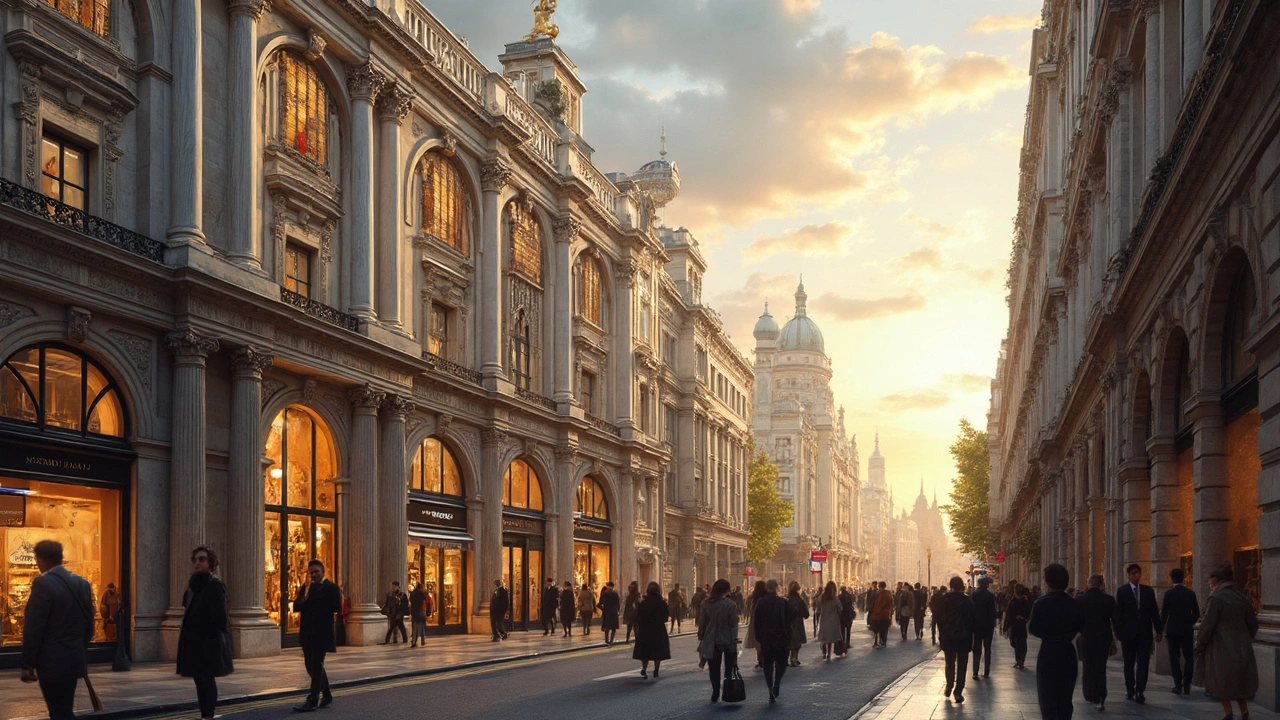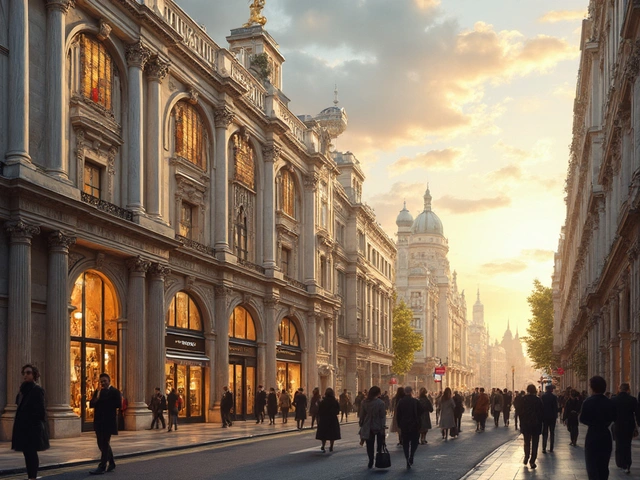Big curves, bold doorways, and ceilings that make you stop and stare—Baroque architecture isn’t just museum stuff. It pops up in modern cities more than you’d think. Ever walked into a mall with a dramatic entrance? Or a public library with sky-high ceilings and lots of light? Thank the Baroque architects from the 1600s for laying the groundwork.
People are drawn to spaces that make them feel something, and Baroque style knows how to trigger those emotions. It’s all about movement, contrast, and grabbing your attention, whether you’re in a grand cathedral or a brand-new shopping center.
Lots of today’s architects and interior designers sneak in Baroque-inspired features—like spiral staircases or oversized windows—because they make everyday places feel special. If you’re curious how to spot these old tricks in new builds, or you're itching to try a bit of that wow-factor at home, you’re in the right place.
- Baroque Basics: What Made This Style Stand Out?
- Modern Cityscapes: Borrowing Baroque Tricks
- Baroque at Home: Design Tips for Everyday Spaces
- Why Baroque Endures: The Real-World Payoff
Baroque Basics: What Made This Style Stand Out?
If you want to spot baroque architecture, look for bold, larger-than-life statements. This style exploded in Italy in the late 1500s and rolled through Europe for over a century. It was all about showing power, wealth, and religious authority, so the buildings weren’t exactly shy. Churches, palaces, even city squares—they got loaded with dramatic features that made people stop and stare.
Baroque buildings go heavy on curves and movement. Facades ripple instead of lying flat. Ceilings are often curved, and they’re packed with art or even real statues bursting out of the walls. The idea? Blow your mind when you walk in the door. That’s why you find loads of giant columns, layered arches, and wide-open spaces that play with light and shadows. Some of the best-known examples—the Palace of Versailles in France and St. Peter’s Basilica in Rome—are still bucket-list spots because of their jaw-dropping scale and detail.
Here’s a quick look at classic Baroque features you can see in both old and new buildings:
- Grand entrances: Oversized doors, often with carvings or arches.
- Sweeping staircases: Usually curving and built to impress (think of the Spanish Steps in Rome).
- Decorative ceilings: Dome-shaped or covered in Fresco artwork.
- Contrast and drama: Heavy use of light and shadow, and a mix of different materials like marble, stucco, and gold leaf.
- Columns and domes: Not just for looks—they guide the eye up, making places feel bigger and grander.
Surprisingly, all this drama was about more than just looks. Baroque designers wanted people to feel moved—literally and emotionally—by the spaces they walked through. When you see a shopping mall with a sweeping glass roof or a modern church with a dramatic entrance, you’re seeing a little bit of Baroque’s DNA in action.
| Feature | Common Baroque Example | Modern Use Today |
|---|---|---|
| Grand Entrance | St. Peter's Basilica | Corporate headquarters lobbies |
| Sweeping Staircase | Palace of Versailles | Luxury hotels, high-end malls |
| Dramatic Light | San Carlo alle Quattro Fontane | Contemporary museums, train stations |
| Decorative Ceilings | Church of the Gesù | Upscale theaters, civic buildings |
So, if you’re after inspiration for your next design project, or you just love buildings that leave a mark, keep an eye out for these classic Baroque moves. They’ve lasted this long for a reason.
Modern Cityscapes: Borrowing Baroque Tricks
Walk around almost any big city and you’ll find little nods to baroque architecture hiding in plain sight. Those swooping lines on a glass office building? Totally Baroque. The fancy plaza with a sculpted fountain and lots of space for people to gather? That’s another Baroque move, just with modern materials.
One of the most obvious Baroque influences is how new developments use dramatic entrances and wide open squares. Think of how New York’s Grand Central Terminal pulls you in with its grand arches and sweeping ceilings. Or check out the shapes at the Walt Disney Concert Hall in Los Angeles—Frank Gehry’s design, all curves and shiny surfaces, takes major hints from Baroque flair (think movement and eye-catching shapes), even if he swapped stone for steel.
City planners love Baroque tricks too. In Madrid, the Plaza Mayor, built in the 1600s, inspired tons of modern plazas worldwide, where people gather, eat, shop, and chill out. Today’s malls, like Westfield London or Dubai Mall, use these principles: big central spaces, plenty of light, dramatic staircases, and ornate details. The feeling you get—drawn in, surrounded by beauty, and even a bit overwhelmed—that’s pure Baroque, even if nobody’s wearing powdered wigs.
If you dig into the design, you’ll see three moves that come straight from Baroque playbooks:
- Sculptural shapes: Rounded corners, flowing facades, and spiral staircases are popping up everywhere. They break up the square, boxy look of standard buildings.
- Light and shade: Tall glass panels, skylights, and clever lighting create deep shadows and bright highlights. It’s about contrast—a classic Baroque favorite.
- Grand entrances: Oversized doors, wide stairs, and tall columns still signal, “Hey, this place matters.”
If numbers help, a 2022 survey by the American Institute of Architects found that 38% of new public buildings in major US cities used curved elements inspired by historic styles, mostly Baroque and Rococo. That’s a big shift from the all-glass, straight-line obsession of the early 2000s.
So, when you see a new library with a wavy roof or notice a hotel lobby’s over-the-top chandelier, you’re looking at the lasting impact of baroque architecture in the city today. It’s proof that classic moves still make our built world more exciting.

Baroque at Home: Design Tips for Everyday Spaces
Don’t have an old palace or a giant church? You can still bring that bold baroque architecture feel into your place without needing a million bucks or a team of experts. It’s more about picking the right details than turning your living room into Versailles.
The main thing: Baroque is about drama and curves. Replace boxy shapes with furniture or decor that has round edges or carved details. Even just one curved accent chair or a mirror with a wavy edge gives a hint of that 17th-century look, but fits right into a modern design style.
- Accent Walls with Bold Colors: Deep reds, blues, and golds were baroque favorites. Paint one wall or use rich wallpaper with big patterns to get that wow effect and add depth.
- Ornate Lighting: Chandeliers are classic baroque. Swap your basic ceiling light for a mini-chandelier or a light with crystal accents in your dining area or entryway.
- Statement Mirrors: Mirrors with oversized, gold-finished frames highlight that baroque flare and bounce light around your room, making it look bigger and brighter.
- Mixing Old with New: Pair a modern sofa with a carved, curvy coffee table or toss some velvet cushions into the mix. A little texture goes a long way.
Believe it or not, these tweaks don’t need a massive budget. A 2023 home decor survey found that adding just one statement piece increased people's feelings of comfort and luxury at home by 29% on average. Here’s a simple breakdown of affordable ways to get started:
| Baroque Feature | Average Cost |
|---|---|
| Paint/Wallpaper | $40 - $200 per room |
| Decorative Mirror | $60 - $300 |
| Mini Chandelier | $90 - $350 |
| Velvet Cushions | $25 - $70 each |
So, you don’t have to break the bank or call a contractor to add a bit of baroque architecture flair. Hunt for deals, shop secondhand, and get creative. You’ll make your space feel special, all while tapping into a design trend that’s been wowing people for centuries.
Why Baroque Endures: The Real-World Payoff
So why does baroque architecture still stick around in our modern world? The answer isn’t just nostalgia. The real win is how it delivers both on style and function. You get looks, but you also get buildings that people actually want to be in. That combo explains a lot about the baroque comeback.
First up, spaces built with baroque inspiration feel inviting and memorable. There’s research that proves people spend more time in places that spark their curiosity—think museums with sweeping staircases or churches with those dramatic domes. Big, bright interiors help with crowd flow in airports and hospitals too, so it’s not just about looking good. The science backs it up: people’s stress levels drop when they’re in spacious, well-lit areas—a classic baroque trick.
You’ll also notice baroque touches make buildings easier to navigate. Grand entrances and detailed facades act like visual signposts. This isn't just fancy talk; it really works. For example, city planners in Vienna and Paris copied baroque street layouts with long, straight avenues leading to massive landmarks. That makes getting around the city simpler and keeps tourism buzzing.
- Baroque architecture gives buildings instant "icon" status. Tourists flock to places like St. Peter’s Basilica and the Palace of Versailles for a reason.
- Modern shopping centers and hotels use baroque ideas—high ceilings, attention-grabbing fronts—to bring in crowds and keep people coming back.
- Baroque spaces are also practical for performances or crowded events. Curved walls and open plans boost natural acoustics. That’s why so many old churches or theaters still host concerts.
And if you care about return on investment, here’s a little fact: Properties with dramatic, classic details (think columns, arches, or giant entryways) can sell for 5-10% more compared to plain boxes. People pay more for homes and offices where design makes an impression. Modern architects know this and often borrow straight from the baroque architecture playbook.
Bottom line, the baroque style lasts because it just works. It draws people in, helps them move around, and even boosts property value. The payoff is more than pretty pictures—it’s money in the bank, happier crowds, and buildings people actually remember.





